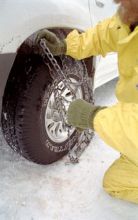
Snow chains are a smart investment. You do not want to be caught on the side of the road during a big snow storm without them. Even with a four-wheel-drive, it’s nice to have tire chains for those extra icy conditions. Be aware that chain requirements change as snow conditions change.
Lake Tahoe Chain Requirements
- Requirement Level 1: Chains, traction devices or snow tires are required on the drive axle of all vehicles except four-wheel/ all-wheel-drive vehicles.
- Requirement Level 2: Chains or traction devices are required on all vehicles except four-wheel/all-wheel-drive vehicles with snow-tread tires on all four wheels.
(NOTE: Four-wheel/all-wheel-drive vehicles must carry traction devices in chain control areas.) - Requirement Level 3: Chains or traction devices are required on all vehicles, no exceptions.
Chain Controls
- You must stop and put on chains when highway signs indicate chains are required. You can be cited by the California Highway Patrol and fined if you don’t. You will usually have about a mile between Chains Required signs and the checkpoint to install your chains.
- Control areas can change rapidly from place to place because of changing weather and road conditions.
- The speed limit when chains are required is 25 or 30 miles an hour.
- Wait until you can pull completely off the roadway to the right before trying to put on chains. Do not stop in a traffic lane where you will endanger yourself and block traffic.
- If you use the services of a chain installer, be sure to get a receipt and jot the installer’s badge number on it. Remember, chain installers are independent business people, not Caltrans employees. Having the badge number may help with any misunderstandings later. Chain installers are NOT allowed to sell or rent chains. And don’t forget to tip!
- When removing chains, drive beyond the signs reading End of Chain Control to a pull-off area where you can safely remove them.
Caltrans Highway Information Network (CHIN):
Call (800) 427-7623 for up-to-the-minute information in California and Western Nevada (Lake Tahoe/Reno Area). The network is updated as conditions change and is voice activated for safety and convenience.
Courtesy of the California Department of Transportation







